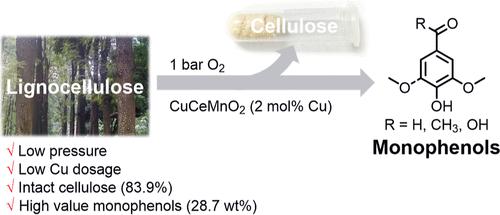掺杂铜锰的 CeO2 对木质纤维素氧化催化分馏的促进作用
IF 13.1
1区 化学
Q1 CHEMISTRY, PHYSICAL
引用次数: 0
摘要
氧化催化分馏(OCF)是一种有效的木质纤维素价值化方法,可同时生产单酚和纤维素。为了获得足够的单酚产量,木质素氧化通常需要较高的氧气压力和过量的铜催化剂(相对于木质素中的芳香单元,铜用量约为 3-5 摩尔当量)。然而,这些条件对纤维素来说相对苛刻,会导致纤维素严重分解成脂肪族酸。为了解决单酚产量和纤维素产量之间的权衡问题,我们开发了一种使用 CuMnCeO2 固溶体作为催化剂的增强型 OCF。在相对温和的条件下(特别是 0.1 MPa O2),使用催化量的铜(相对于木质素中的芳香单元,铜的用量约为 0.03 摩尔当量),从桦木中释放出 28.7 wt % 的单酚。同时,高达 83.9% 的纤维素被收集为固体纸浆。研究发现,掺杂金属(铜和锰)与氧空位之间的协同效应是在温和条件下增强木质素氧化作用并最大限度减少纤维素损失的关键。丰富的表面氧空位促进了分散良好的 Cu 和 Mn 物种对氧的活化,而这些金属之间的强相互作用增强了催化剂的还原性。通过模型实验确定了关键的中间产物,如 β-乙烯基芳基醚和副产物乙醇酸,证实了木质素氧化主要遵循 1,2-二氧杂环丁烷均解机制。总之,这种增强型 OCF 证明了木质素氧化在实际生物精炼应用中的潜在可行性。本文章由计算机程序翻译,如有差异,请以英文原文为准。

Oxidative Catalytic Fractionation of Lignocellulose Enhanced by Copper–Manganese-Doped CeO2
Oxidative catalytic fractionation (OCF) represents an efficient approach to valorize lignocellulose for coproduction of monophenols and cellulose. To achieve an adequate monophenol yield, lignin oxidation, typically, requires high O2 pressure and an excess of Cu catalysts (the Cu dosage is approximately 3–5 mol equiv relative to the aromatic units in lignin). However, these conditions are relatively harsh for cellulose, resulting in severe decomposition to aliphatic acids. To address the trade-off between the monophenol yield and cellulose production, we develop an enhanced OCF using a CuMnCeO2 solid solution as the catalyst. Under relatively mild conditions (specifically, 0.1 MPa O2), 28.7 wt % monophenols were released from birch, using catalytic amounts of Cu (the Cu dosage was about 0.03 mol equiv relative to the aromatic units in lignin). Meanwhile, up to 83.9% of cellulose was collected as a solid pulp. The synergistic effect between doped metals (Cu and Mn) and oxygen vacancies was found to be crucial for enhanced lignin oxidation under mild conditions with minimized cellulose loss. The abundant surface oxygen vacancies facilitated oxygen activation by well-dispersed Cu and Mn species, while the strong interaction between these metals enhanced the catalyst’s reducibility. Key intermediates such as β-vinyl aryl ethers and byproduct glycolic acid were identified by model experiments, confirming that lignin oxidation primarily followed a 1,2-dioxetane homolysis mechanism. Overall, this enhanced OCF demonstrates the potential viability of lignin oxidation in practical biorefinery applications.
求助全文
通过发布文献求助,成功后即可免费获取论文全文。
去求助
来源期刊

ACS Catalysis
CHEMISTRY, PHYSICAL-
CiteScore
20.80
自引率
6.20%
发文量
1253
审稿时长
1.5 months
期刊介绍:
ACS Catalysis is an esteemed journal that publishes original research in the fields of heterogeneous catalysis, molecular catalysis, and biocatalysis. It offers broad coverage across diverse areas such as life sciences, organometallics and synthesis, photochemistry and electrochemistry, drug discovery and synthesis, materials science, environmental protection, polymer discovery and synthesis, and energy and fuels.
The scope of the journal is to showcase innovative work in various aspects of catalysis. This includes new reactions and novel synthetic approaches utilizing known catalysts, the discovery or modification of new catalysts, elucidation of catalytic mechanisms through cutting-edge investigations, practical enhancements of existing processes, as well as conceptual advances in the field. Contributions to ACS Catalysis can encompass both experimental and theoretical research focused on catalytic molecules, macromolecules, and materials that exhibit catalytic turnover.
 求助内容:
求助内容: 应助结果提醒方式:
应助结果提醒方式:


